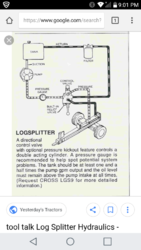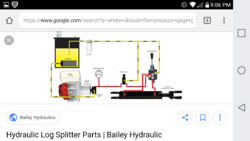About a year ago, I traded a very worn out Polaris Ranger for a plethora of items from a friend with a tree service; guns, grills, etc.... One item was a wood splitter that had sat idle in his wood yard with the engine and pump gone for a while (it was a 1997 yard machine). About $675 later it's basically a new machine except for the ram, frame, I-beam, and tires. I've learned a lot and have actually enjoyed putting it together for the most part.
I've been perusing threads on tonnage requirements, it occured to me that I have no idea what I have now, and what I should expect when I start splitting. I live in South Carolina in the middle of timber country and have easy access to hardwoods when the loggers are gone, and this includes Live oak. I stop every day after work and come home with my truck on the springs.
Anyway, I'm not really sure what I have (tonnage wise) with this frankenstein machine and was hoping some brainiacs and more "seasoned" dudes could help me based on the following:
It has an almost new 8 hp honda, coupled to a 13.6 gpm pump. I just bought a new Nortrac 2 stage valve, as I found out the old "energy" one had a max gpm of 10 gpm and had some blown o-rings. I'm hoping to get it all back together soon and test it out.
Is that enough info to give an idea of the tonnage? Will this set up split live oak without blowing anything? Growing up we cleared land and split wood in the winter to sell with splitters that were completely homemade. I've spent hundreds of hours sitting in front of one (as my bad hearing would testify), so I know about repositioning wood and flat out chunking some crotch pieces here and there. Just want to know what I have really. Thanks in advance.
I've been perusing threads on tonnage requirements, it occured to me that I have no idea what I have now, and what I should expect when I start splitting. I live in South Carolina in the middle of timber country and have easy access to hardwoods when the loggers are gone, and this includes Live oak. I stop every day after work and come home with my truck on the springs.
Anyway, I'm not really sure what I have (tonnage wise) with this frankenstein machine and was hoping some brainiacs and more "seasoned" dudes could help me based on the following:
It has an almost new 8 hp honda, coupled to a 13.6 gpm pump. I just bought a new Nortrac 2 stage valve, as I found out the old "energy" one had a max gpm of 10 gpm and had some blown o-rings. I'm hoping to get it all back together soon and test it out.
Is that enough info to give an idea of the tonnage? Will this set up split live oak without blowing anything? Growing up we cleared land and split wood in the winter to sell with splitters that were completely homemade. I've spent hundreds of hours sitting in front of one (as my bad hearing would testify), so I know about repositioning wood and flat out chunking some crotch pieces here and there. Just want to know what I have really. Thanks in advance.


 it’s amazing that I’m not deaf already!
it’s amazing that I’m not deaf already!

